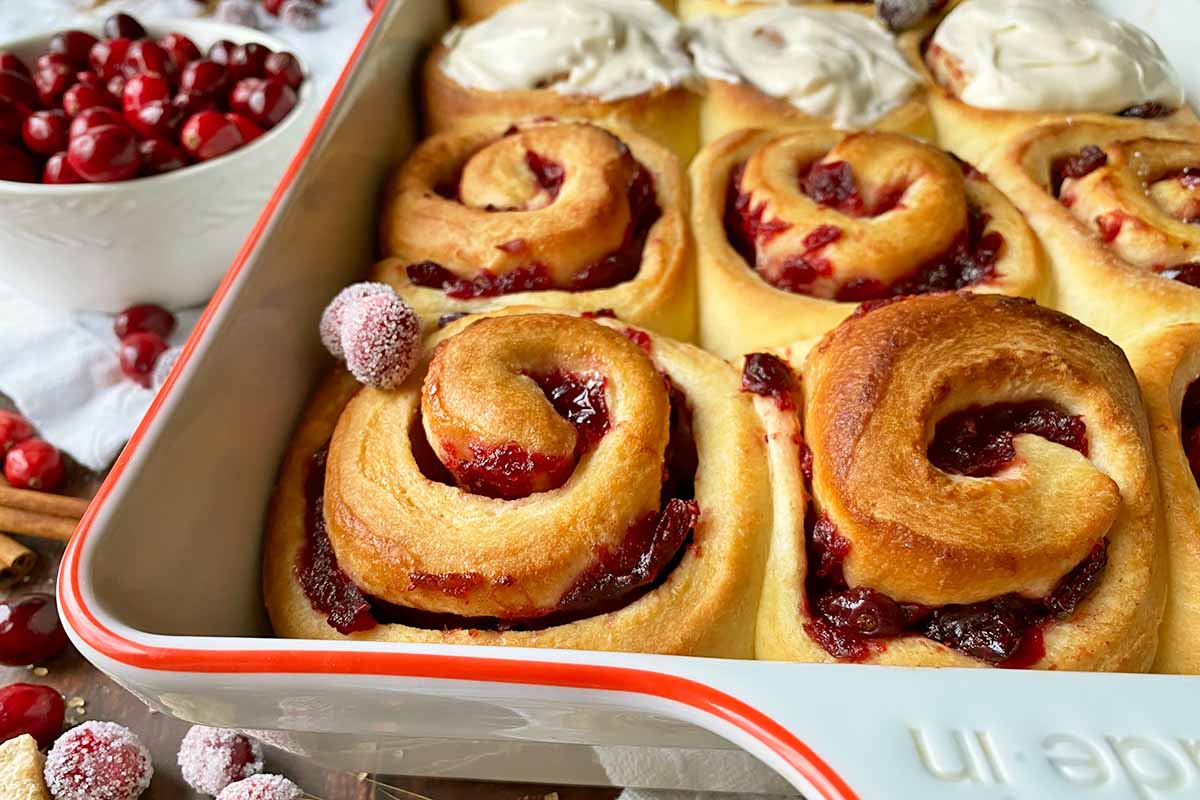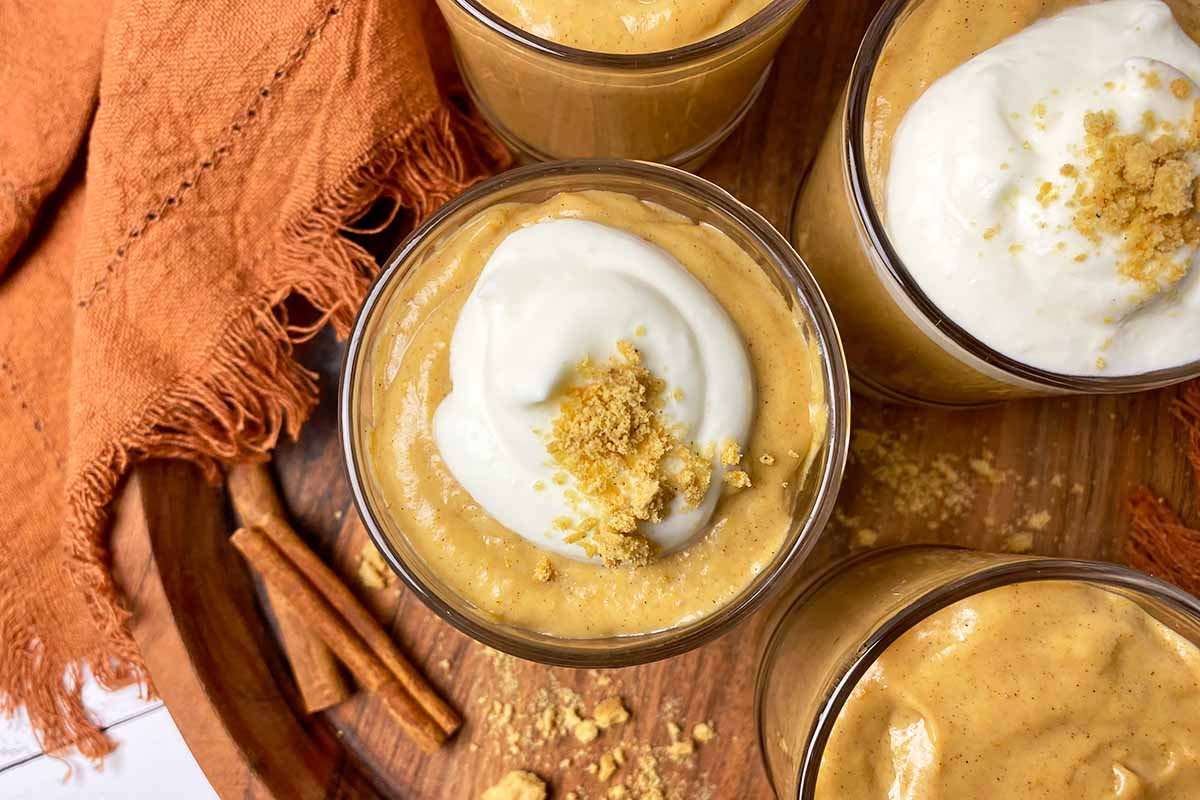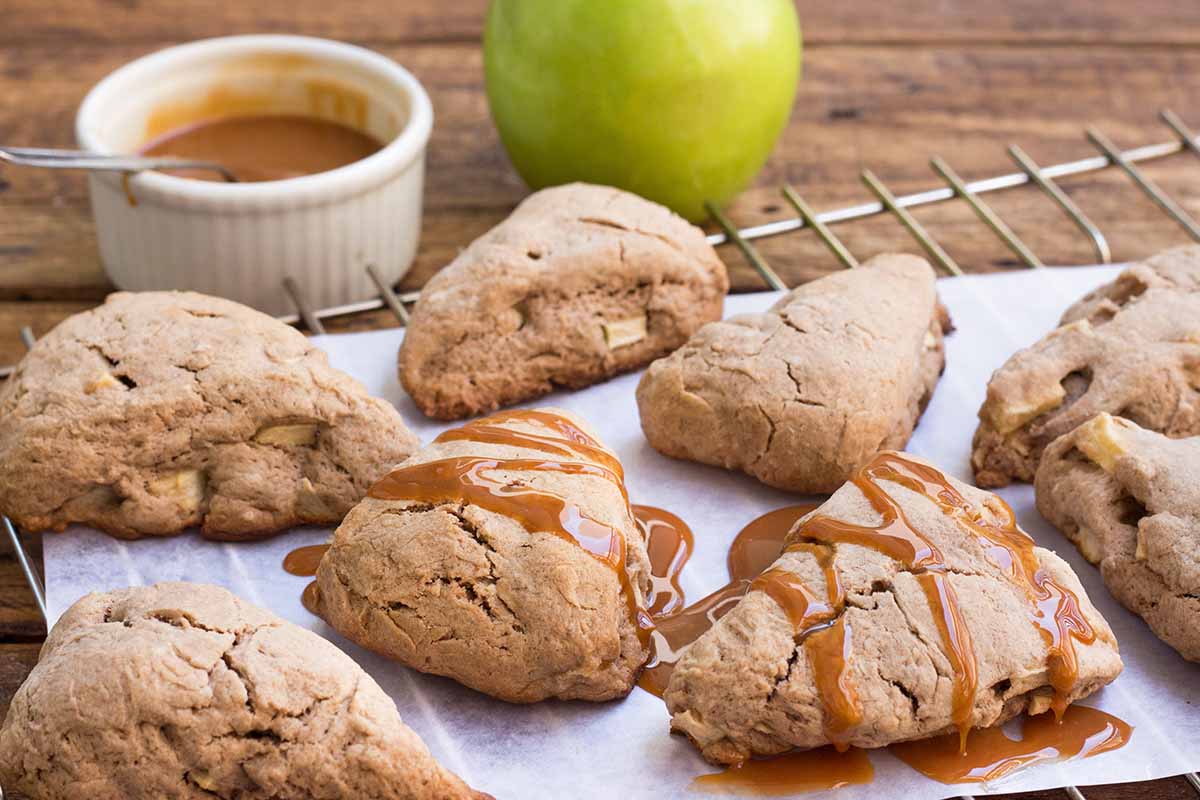Picture this: you’re in a cemetery at night, standing alongside a tombstone.

Several lit candles line the top of the stone, and at its base lays a pile of marigolds. Leaning up against the stone is a bottle of tequila.
On the other side stands a table draped in colorful fabric. On the top you see several photographs, more candles, a loaf of bread, a jar of candies, more marigolds, and other special odds and ends.
Several other people are at the graveside with you, milling around and talking, and across the cemetery you see the same scene played out at many other graves.
You may be wondering what in the world is going on here, but in many parts of the world – especially in Mexico and various Latin American countries – the answer is obvious:
You’re celebrating Dia de los Muertos!
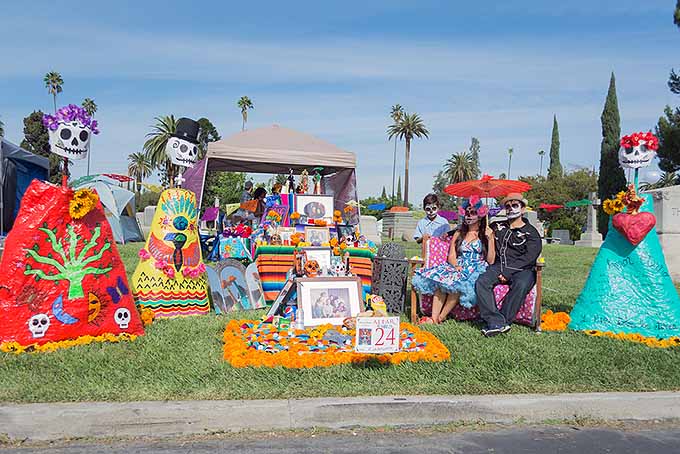
While Halloween is a super fun holiday and I completely love every second of it, there is such beauty in in its sister holiday, Dia de los Muertos, that I have a hard time deciding which celebration I love more!
I grew up celebrating Halloween, but I was also raised by a Mexican step-dad and then married a Mexican husband, so the Mexican Day of the Dead has been a part of my life for a long time.
With the huge population of Hispanics in the United States now, it seems like this celebration is pretty common most everywhere, and many Americans seem to have embraced this festivity as one of their own.
For those of you who want to learn more about this festival, you’ve come to the right place.
What Are the Roots of Dia de los Muertos?
Much like Halloween, the origins of All Saints Day and All Souls Day (November 1 and 2) lie in the distant past of the indigenous peoples of central and southern Mexico.
The Aztec empire was the ruling power in this region from the 14th through the 16th centuries.
During this time, one of the gods they worshipped was the King of the Underworld, Mictlantecuhtli. His wife was Mictecacihuatl, Lady of the Dead.
At the beginning of the ninth month of the Aztec calendar, which corresponds to our August, the Aztec people began a month-long festival of the dead honoring the Lady of the Dead.
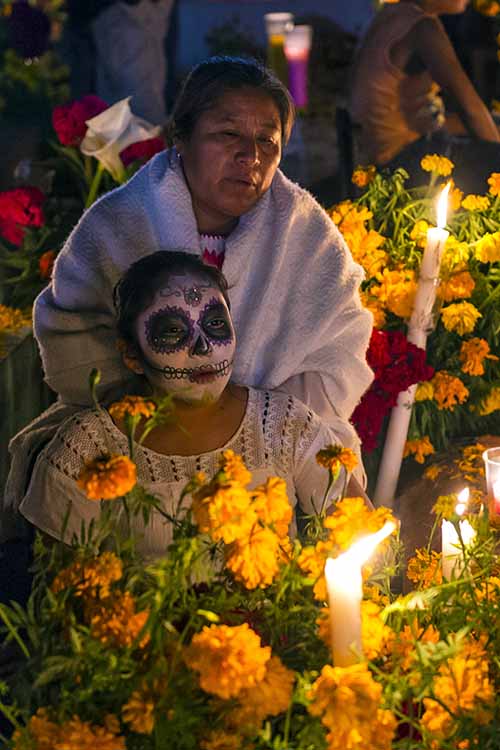
After the Spanish colonization of Mexico in the 1600s, Catholicism began to take over.
To help stamp out the pagan Aztec religion, the conquerors moved the celebration to November 1 to coincide with their All Saints festivities.
This was a natural move, when you think about it.
The European tradition of honoring the dead on Halloween and All Saints Day matches up quite well with the Aztec history of worshipping the King and Queen of the Underworld and paying homage to their dead.
What Does the Celebration Look Like Today?
As far as the modern holiday goes, writer Frances Ann Day gives the best synopsis that I’ve seen:
All Saints and All Souls
“On October 31, All Hallows Eve, the children make [an] altar to invite the angelitos (spirits of dead children) to come back for a visit.
November 1 is All Saints Day, and the adult spirits will come to visit. November 2 is All Souls Day, when families go to the cemetery to decorate the graves and tombs of their relatives.
The three-day fiesta is filled with marigolds, the flowers of the dead; muertos, the bread of the dead; sugar skulls; cardboard skeletons; tissue paper decorations; fruit and nuts; incense; and other traditional food and decorations.”
For more of Day’s writings on this and other subjects, check out her book Latina and Latino Voices in Literature, available on Amazon.
I think the altars are the most recognizable feature of this festival. They are so beautiful and vibrant, and I love looking at all the photos and decorations.
While marigolds are definitely the main flower of the holiday, there are also other flowers of all colors everywhere.
Right up there with the altars are the ever-present skeleton faces.
Like many ancient people, the Aztecs held the skull as sacred, and they would have displayed many of them during their celebration honoring Mictecacihuatl. They were seen as a symbol of death and rebirth.
The skull became set in stone (pun intended) as a symbol of the holiday when Jose Guadalupe Posada’s zinc etching La Calavera Catrina became popular around 1910.
Since that time, people have been painting their faces to mimic skeletons as part of their annual festival of death.
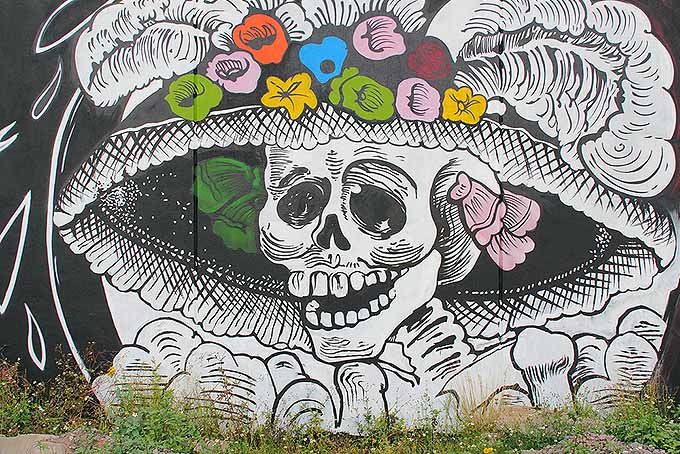
Now it’s a pretty common occurrence to have a Dia de los Muertos parade with the participants all painted up like skeletons, and wearing traditional Mexican dresses and suits.
Sadly, we don’t have a parade where I live. But one day I would love to watch the procession, or even participate!
What Exactly Goes on the Altar?
Altars (or ofrendas) may be erected at a graveside, in the home, or even alongside many others at a community celebration, like the one I attend at an art gallery downtown.
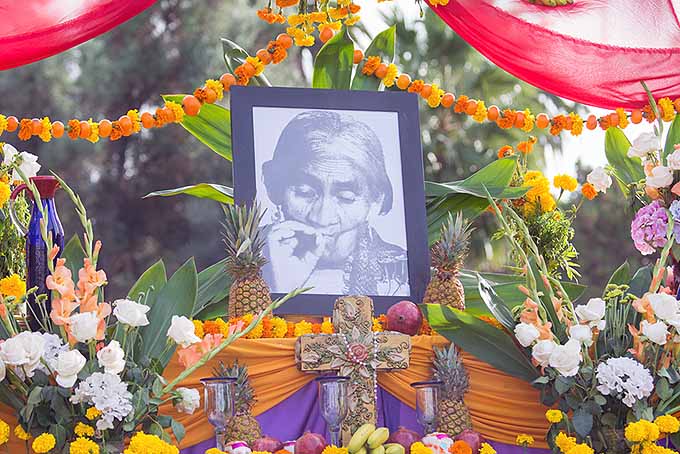
Favorite foods and beverages of the deceased are generally laid out in their remembrance. Photos and other mementos of the dead are also typically displayed.
The intent of the ofrenda is to urge the souls of lost family and friends to come back to visit the living.
Marigolds are believed to especially entice the dead, and for this reason, that bright, golden flower is often seen as decoration on the altars.
If the altar is for a child, it is very common to see an offering of toys on display. For adults, a bottle of tequila or a jar of atole (a traditional Mexican beverage) is often included.
Altars in cemeteries or homes tend to have a religious component as well, such as a cross or a depiction of the Virgin Mary. A rosary may also be laid out, along with several lit candles.
These items are usually left off of ofrendas in public buildings and schools.
Of course, no Dia de los Muertos ofrenda would be complete without an offering of food.
The food that is placed on the altar is frequently consumed later by the celebrants, but they believe that the food no longer has any nutritional value.
Once the spirits have come to “visit” at their altars, they partake of the “spiritual essence” of the offerings.
Sugar Skulls
Let’s talk about what sorts of edible gifts you might see on an altar.
The most familiar item that almost everyone would associate with this time of year is the sugar skull.
It’s sort of the unofficial icon of the festival, but this particular component is a more recent development than other parts of the celebration.
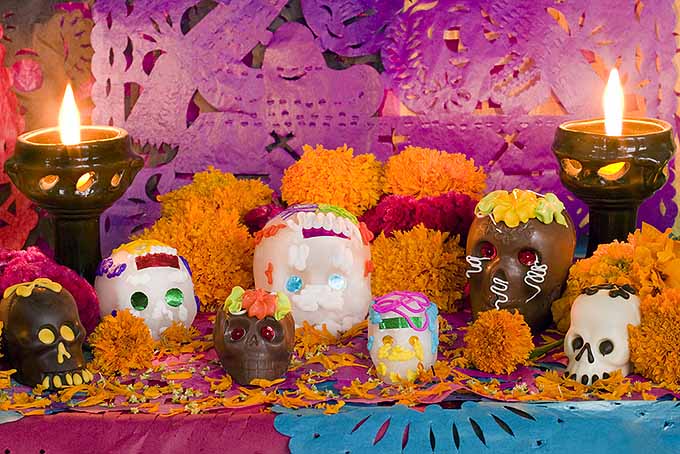
The art of the sugar skull first appeared on the scene in the New World in the 17th century, brought overseas by Italian missionaries. The first use of this confectionary skill was recorded in Palermo, as a decoration during the Easter Mass.
Once the relatively poor Mexican villagers learned of this Italian tradition, they decided to make their own sugar decorations to adorn their festivals and religious ceremonies. They wouldn’t have had the funds to purchase imported European items to embellish their churches or altars.
Sugar skulls were traditionally made from cane sugar using molds. Now it’s more common to use a mixture of meringue powder and granulated sugar mixed with water.
You can also add paste food coloring to the water to create colorful designs on the skulls.
Over time, in addition to the sugar skulls, artisans began crafting skulls from clay as well. These calaveras have an advantage over the sugar variety as they can be used again and again over the years with less chance of breaking.
It’s also become commonplace to make chocolate ones that are more popular with children.
Pan de Muerto
An altar offering that may not be as familiar to those outside of Hispanic communities is the pan de muerto, literally the bread of death.
If you have had a regular Mexican pan dulce, then the pan de muerto would be recognizable to you in both taste and texture.
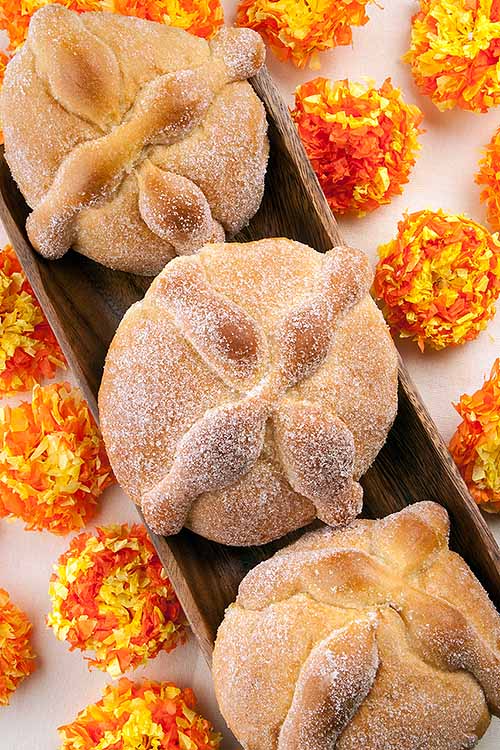
This is another type of Mexican sweet bread and that is made using a basic sweet bread dough recipe.
The main difference with the pan de muerto is that on top of the bun-shaped bread the baker uses two smaller pieces of dough formed in the shape of finger bones to make a cross.
As a final touch, the top will be covered in a thick coating of granulated sugar.
I have also seen the finger bones made out of a thick, white frosting that is applied after the bread is baked. Either way, they are both delicious!
My local Mexican panaderia sells out of their pan de muerto just a few hours after they make it.
Atole
Offerings of beverages are common on altars both in the home or at the cemetery. It’s no surprise to see full bottles of tequila at many graves, which are of course taken home for use after November 2.
Another traditional drink is Mexican atole.
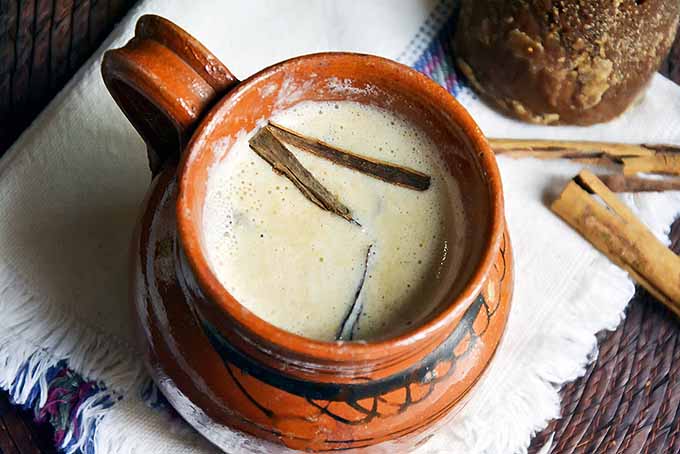
Now, I’m not going to lie: I do not like atole. My Mexican husband has made me try it on more than one occasion, and I seriously dislike it.
It’s not the taste so much, but it’s really thick, and I just do not like the way it feels in my mouth.
But my husband loves the stuff. He always makes it with some packaged product, so I would love to make a batch from scratch and see if I like it better that way. It seems like it would be simple enough to make.
It only takes five simple ingredients to make your own atole. First, there’s masa, which is the corn or hominy flour that’s used to make the dough for tamales.
This is toasted and then mixed with water, piloncillo (Mexican unrefined cane sugar, which is DELICIOUS), cinnamon, and vanilla.
The masa and water are whisked together first to make the thick, creamy drink, and then the other ingredients are added for flavor.
At least in theory, it sounds really good. So I will definitely be making some at home this Dia de los Muertos, to give it another try!
If you’re interested in making some atole yourself, masa can be found at pretty much any grocery store these days in the ethnic food aisle, and piloncillo is easy to find at any Mexican market.
A side note: while you’re in the Mexican grocery store, go ahead and buy your cinnamon, too. It’s often Ceylon cinnamon or canela, and I find it packs a much bigger punch than what I buy at my usual grocery store.
Create Your Own Dia de los Muertos at Home
All in all, this really is a beautiful holiday. And it’s so nice to take this time to remember the loved ones you’ve lost over the years.
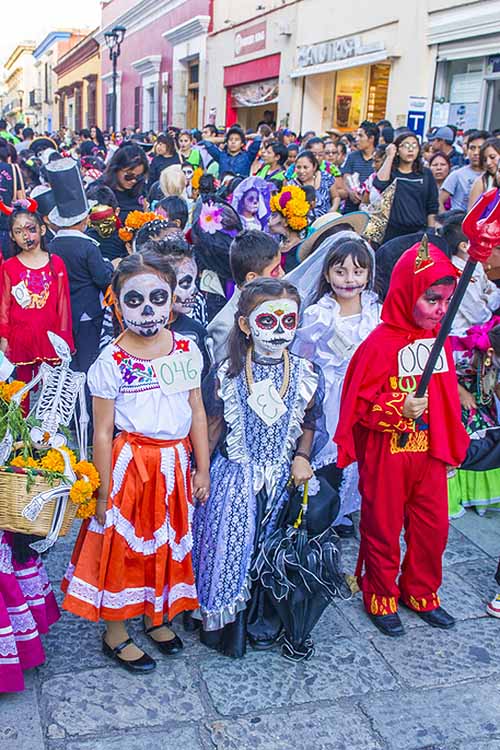
It’s really easy to have your own simple celebration at home, and there’s no need to get extravagant.
Clear off a side table in your living room, or wherever you have space. Gather a few photos of any grandparents, parents, friends, or anyone else you’ve lost and place them all together on the cleared table.
Any mementos you have from those loved ones can be placed on the table as well.
For example, I have a silver brush and comb set that belonged to my great-grandmother that I like to set out. My husband has a watch that his father gave to him that always brings on the reminiscing.
Complete your decorations with a colorful vase of marigolds (or, if you like crafting, make your own with tissue paper). Add a few candles, and you’ll be all set.
Take some time each day leading up to November 1 to light the candles and sit quietly by your little altar, remembering all the good times you shared with those special people.
On November 1 or 2, head to your local Mexican bakery to purchase some pan de muerto and sugar skulls to add to your ofrenda.
You may also want to try your hand at making atole, and you can even cook or bake a food that was a favorite of a lost loved one. I might even set out a dish of Werther’s Originals, my mamaw’s favorite candy.
Check your local festival guide to see if there’s a communal Dia de los Muertos celebration.
It’s always fun to go look at all the big altars that are set up there and watch the parade (complete with celebrants in costume and skull faces) or the Mexican folkloric dance performances.
Bringing it Home
In whatever way you decide to incorporate a little of this beautiful festival into your home, it will definitely be worth it, and so meaningful. A celebration of love, family, culture, history, and food – what could be better?
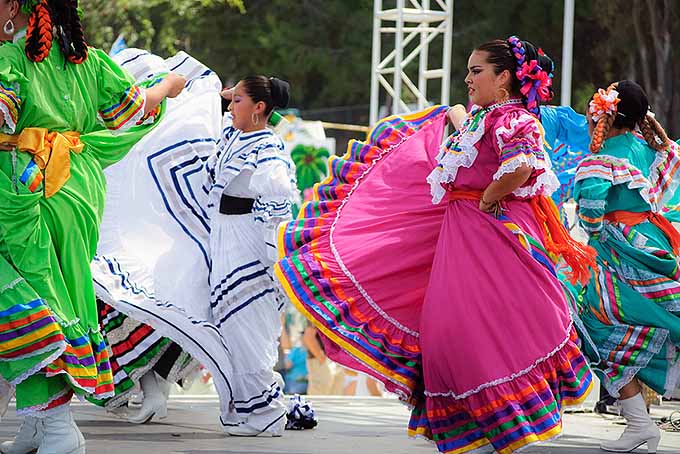
How will you celebrate the Day of the Dead this year? Let us know in the comments!
Photo credit: Shutterstock.
About Ashley Martell
Ashley has enjoyed creative writing since she was six years old, when she wrote her first short story. She majored in English literature at the University of Montevallo. After years of professional work, she is now a stay-at-home mom of three, who uses her craft to write about her life and adventures in and out of the kitchen.

